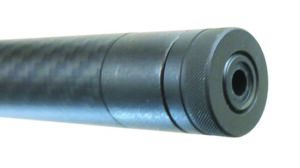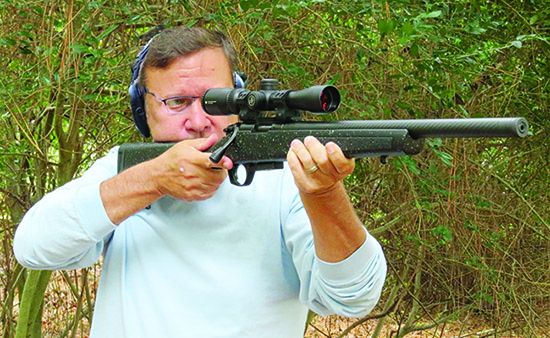A 22 LR bolt-action rifle is a staple in any gun safe. These low-recoil, inexpensive-to-shoot guns are great training rifles and fun plinkers. They also make great small-game hunting rifles. We wanted to take a look at how a pair of affordable, inexpensive rifles would compare to two premium rifles costing double and triple what the price of the affordable guns were and see if we could assess a Best Buy rating. Or, would the premium guns so knock our socks off that we’d recommend one of the more expensive firearms as an Our Pick.
The premium guns consisted of the Bergara BMR ($650) and Ruger’s American Rimfire Target ($505), and the two affordable rifles were the Savage MK II FVXP ($305) and Mossberg’s 802 Plinkster ($190). Three of the four 22 LR bolt-actions were equipped with an 18-inch barrel and were optics ready. The Savage came with a factory mounted scope and a 21-inch barrel. The Bergara, Ruger, and Mossberg all handled like carbines, while the Savage handled more like a rifle. Standard equipment among all four rifles were sling swivel studs onto which you could also mount a bipod on the front stud if you so desired, a protruding cocking indicator, two-position manual safety, and removable box magazines of either steel or polymer. We wanted to see if paying extra for a 22 LR rifle translated into better performance. Our success criteria were accuracy and ease of use.
The Savage came with a factory-mounted Weaver 3-9x40mm SFP scope. The clarity was good, and the reticle was a simple Duplex shape, which Weaver calls a Dual-X reticle. The Weaver and the Savage worked well together. A Vortex Crossfire II 2-7x32mm rimfire SFP scope ($179; VortexOptics.com) was mounted with Vortex Pro Series 1-inch medium-height rings ($79; MidwayUSA.com) for the Bergara and the Ruger. The rings used on the Mossberg were NCStar 3⁄8-inch dovetail 1-inch rings ($13; Amazon.com). The clarity in the Vortex scope was very sharp, noticeably better than the Weaver scope. A V-Plex MOA reticle, similar to a simple Duplex reticle, was inside the Vortex’s tube.
How We Tested
We bored-sighted the Vortex scope on the Bergara, Mossberg, and Ruger. The Savage was bore-sighted at the factory. Using a range bag as a rest, we zeroed for 50 yards and commenced accuracy testing. Ammunition consisted of Winchester Xpert HV with a 36-grain HP bullet, a hot Aguila Supermaximum cartridge loaded with a 30-grain copper-plated solid bullet, the classic Remington Thunderbolt with a 40-grain lead roundnose bullet, and the hot CCI Velocitor round using a 40-grain copper-plated hollow point.

We also used two new toe bags under our rifles because our sand-filled gym sock gave up the ghost. The CVLife ($23; CVLife.com) rear squeeze bag is made of 1000-denier polyester so it should survive frequent use. It came with a pouch pre-filled with plastic beads that is accessible through a zipper so you can remove it and add sand or whatever fill you want. The bag is designed in the shape of rectangular pancake and offers different heights for different needs. We liked this bag because it was very light weight and had enough give so you could squeeze it to adjust your sight picture. The OneTigris bag ($17; OneTigris.com) is made of 500D Cordura nylon and also come pre-filled with lightweight plastic pellets, but there is no zipper to remove, add, or exchange the fill. We found this bag had less give and was too hard to squeeze to adjust elevation. With use it started to give, but we wanted more give so that when we squeezed it, it would suit our aiming needs. The OneTigris is shaped like a cylinder and offered fewer height options than the CVLife bag. Both bags had Velcro straps so you can attach them to your gear.
After sending plenty of lead down range and sweeping up plenty of 22 rimfire empties, we found that both the Ruger and Bergara are quality-built rifles with better overall accuracy and more features than the Savage and Mossberg, hence the price difference. But they were very different products themselves; the Bergara is ultra lightweight, and the Ruger is heavy. Price, however, was not a requirement for accuracy, as we found with the inexpensive Mossberg. There is a lot to like about these rifles for any budget.
Bergara BMR Carbon Model BMR002 22 LR
$650
GUN TESTS GRADE: A (Our Pick)
The BMR is super lightweight and had darn good accuracy off the bench. The stock was comfortable for adult-size shooters, and the action was slick.

| Action Type | Bolt, 60-degree lift |
| Overall Length | 36.0 in. |
| Barrel | 18.0 in., bull, threaded muzzle, 1:16 twist |
| Muzzle Device | None |
| Sights | None, integrated 30-MOA rail |
| Overall Height w/o scope | 6.6 in. |
| Weight Unloaded w/o scope | 5.0 lbs. |
| Weight Loaded w/o scope | 5.1 lbs. |
| Stock | Black synthetic |
| Stock Length of Pull | 13.7 in. |
| Stock Buttplate | Rubber |
| Action Finish | Matte black |
| Barrel Finish | Black |
| Magazine | (2) Detachable polymer boxes, 5 & 10 rounds |
| Trigger Pull Weight | 2.6 lbs., adj. |
| Safety | Manual |
| Accuracy Guarantee | NA |
| Warranty | Lifetime |
| Telephone | (877) 892 7544 |
| Website | BergaraUSA.com |
| Made In | Spain |
Bergara introduced the BMR (Bergara Micro Rimfire) in 2021 as a hybrid rimfire bolt for both hunting and the base class of National Rifle League NRL22-style competition. NRL22 is a sport-rifle shooting competition for precision 22 LR rifles. The BMR is a micro version of Bergara’s B-14 series. It is lightweight, coming in at 5 pounds sans optic. Part of the weight savings with the BMR is due to the carbon-fiber bull barrel with a match chamber and threaded muzzle. The barrel is built with a carbon-fiber tube over the steel liner. The carbon-fiber barrel is the cool factor with the BMR. Even though the barrel is 18 inches long, the overall length of the BMR is 36 inches, the shortest rifle tested. It handles quick and shoulders comfortably.
The black-synthetic sporter-style stock with gray paint flecks has a rubber recoil pad and QD sling studs. There is minimal bedding in the rifle to reduce weight and cost, yet it still feels solid. It is easy to maneuver the BMR because of the weight and length. The bottom edge of the stock is flat so the rifle is easier to keep steady when firing from a rest. The plastic pistol grip cap is molded with the Bergara logo.
The bolt throw is 90 degrees, and the scaled down knob comes close to the scope’s eye piece when manipulating the bolt. The bolt knob is knurled and easy to palm without losing your sight picture. The action is slick, enabling fast follow-up shots while still watching the target through the scope. It uses dual extractors so empties get tossed with no issues. The Picatinny optic rail has a 30-MOA slant so you can get the most out of elevation in the scope for long-range shots.
The trigger is wide and smooth with a nice curve. It is adjustable by turning a hex screw located inside the trigger guard. That’s how a trigger adjustment should be accessed. It takes a Remington 700-style trigger if you want to replace the trigger. The test rifle’s trigger was set at 2.6 pounds and had slight overtravel. Adjustment range according to the manual is 2.8 to 4.4 pounds, but our trigger was slightly under the low range. We liked the trigger as it was because it helped us achieve small groups. A two-position safety is located on the right side of the receiver, designed for a right-handed shooter. Forward is Fire and rearward is Safe. The trigger guard and magwell are all one piece of plastic.
The lightweight rifle feeds from either a five- or ten-round magazine, both of which come with the rifle. The detachable magazines are made of polymer with rounded edges. Though it is not a flush fit, the five-round magazine was comfortable to carry. The magazine-release lever is located just forward of the trigger guard and offers easy access to dump an empty magazine.
Getting behind the BMR, we found the rifle loved the Winchester Xpert HV ammo, giving us a best five-shot group that measured 0.38 inch at 50 yards. Best group with Aguila ammo measured 0.50 inch, and the CCI Velocitor’s best was close behind with a group that measured 0.57 inch. Inexpensive Remington Thunderbolt ammo provided a best group that measured 0.72 inch. The BMR was easily the most accurate rifle in the test. The average group size across all ammo measured 0.63 inch. We can only imagine what size groups this rifle with shoot with match ammo.
Our Team Said: The BMR is a quality-built rifle with nice features, such as an adjustable trigger, smooth-operating bolt, and 30-MOA optic rail. The carbon-fiber barrel checks the cool factor box. This would make a great training rifle, long distance competitor (in the right class), and an all-day hunter. If you want light weight without compromise, then the BMR is an excellent choice.
| 22 LR RANGE DATA | ||||
| Winchester Xpert HV 36-grain HP | Bergara BMR | Mossberg 802 Plinkster | Savage Mark II FXP | Ruger American |
| Average Velocity | 1260 fps | 1176 fps | 1286 fps | 1304 fps |
| Muzzle Energy | 127 ft.-lbs. | 111 ft.-lbs. | 132 ft.-lbs. | 136 ft.-lbs. |
| Smallest Group | 0.38 in. | 0.40 in. | 0.92 in. | 0.95 in. |
| Average Group | 0.55 in. | 1.01 in. | 1.13 in. | 1.03 in. |
| Aguila Supermaximum 30-grain Copper Plated Solid | Bergara BMR | Mossberg 802 Plinkster | Savage Mark II Precision | Ruger American |
| Average Velocity | 1648 fps | 1527 fps | 1617 fps | 1589 fps |
| Muzzle Energy | 181 ft.-lbs. | 155 ft.-lbs. | 174 ft.-lbs. | 186 ft.-lbs. |
| Smallest Group | 0.50 in. | 0.40 in. | 1.98 in. | 0.77 in. |
| Average Group | 0.67 in. | 1.05 in. | 2.14 in. | 0.82 in. |
| Remington Thunderbolt 40-grain LRN | Bergara BMR | Mossberg 802 Plinkster | Savage Mark II Precision | Ruger American |
| Average Velocity | 1264 fps | 1089 fps | 1171 fps | 1283 fps |
| Muzzle Energy | 142 ft.-lbs. | 104 ft.-lbs. | 122 ft.-lbs. | 146 ft.-lbs. |
| Smallest Group | 0.72 in. | 0.93 in. | 0.57 in. | 1.16 in. |
| Average Group | 0.73 in. | 1.04 in. | 0.65 in. | 1.19 in. |
| CCI Velocitor 40-grain Copper Plated HP | Bergara BMR | Mossberg 802 Plinkster | Savage Mark II Precision | Ruger American |
| Average Velocity | 1464 fps | 1322 fps | 1412 fps | 1434 fps |
| Muzzle Energy | 190 ft.-lbs. | 155 ft.-lbs. | 177 ft.-lbs. | 183 ft.-lbs. |
| Smallest Group | 0.57 in. | 1.03 in. | 0.58 in. | 0.69 in. |
| Average Group | 0.59 in. | 1.65 in. | 0.73 in. | 0.71 in. |
To collect accuracy data, we fired five-shot groups from a bench using a rest. Distance: 50 yards. Velocities were recorded using a ProChrono digital chronograph set 15 feet from the muzzle.
Written and photographed by Robert A. Sadowski, using evaluations from Gun Tests Team members. GT



























